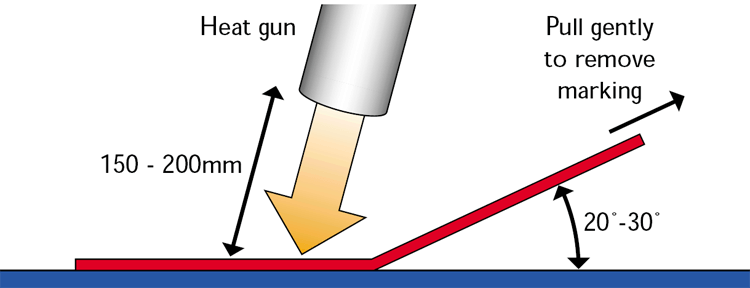Removal of Reflective Markings
Removal tools:
- Industrial Heat Gun
- PA-1 Plastic Applicator
- Synthetic Thinner
- Safety Equipment
Reflective markings cannot be removed at ambient temperatures.
Use heat, following the procedure below to give clean removal with no adhesive residue.

Removal procedure
- Heat one corner of the marking with an industrial heat gun until hot to touch. Start at a bottom corner and work upwards.
- Lift edge of marking and begin by removing the sheeting by stretching the material at a low angle (20°-30°) to the vehicle body.
- Direct the heat gun away from the piece being removed to allow heating of the next area. (If marking stretches excessively or tears, reduce heat by holding heat gun further away or remove the heat for a short time. If marking is difficult to lift or it breaks, more heat is needed)
- Continue to apply heat to the marking while slowly stretching the sheeting along and away from the surface at a low angle (20°-30°). Lifting the sheeting up from the surface at an angle of 45° or greater will leave adhesive on the surface, A temperature that is too hot or too cold will result in adhesive being left on the vehicle.
- Remove adhesive residue by wiping with a cloth saturated in Synthetic Thinner. Allow the thinner to penetrate for 1-2 minutes then rub off with saturated cloth. For heavy adhesive deposits, after soaking , the adhesive can be scraped off using a PA-1 Plastic applicator. Observe safety guidelines when working with this thinner. Thinners should not be used until the hot air gun is moved a safe distance away from the vehicle.
- Ensure all residue is removed prior to the new markings being applied and the surface prepared by solvent wiping, following the procedures outlined in the application notes.Removal when air temperature is below 60°F will require more time because of heat loss from the surface removal. Care should always be taken to ensure that the surface is not overheated and that heat sources do not come in to contact with the solvents used in adhesive removal.
- The application of heat when removing vinyl from composite box bodies may cause some de-lamination. Care should be taken if this does occur not to damage the outer skin. Once the body has cooled the outer skin should shrink back to its original shape.